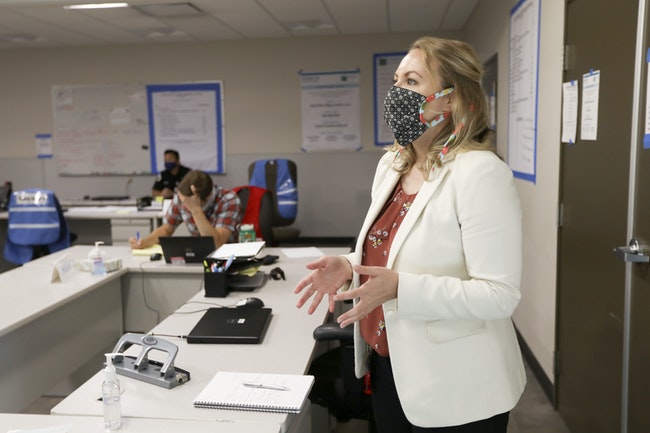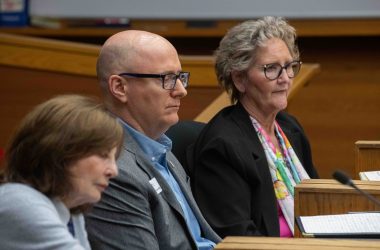 Katrina Rothenberger, incident commander, stands in the COVID-19 incident command at the Marion County Health and Human Services office on Monday, July 13. (Amanda Loman/Salem Reporter)
Katrina Rothenberger, incident commander, stands in the COVID-19 incident command at the Marion County Health and Human Services office on Monday, July 13. (Amanda Loman/Salem Reporter)
Marion County epidemiologists have linked about 30 cases of coronavirus in the past two weeks to social gatherings like potlucks and bachelorette parties after placement on a state watchlist prompted a more thorough review of data.
It’s a small proportion of the 521 residents diagnosed with the virus during that timeframe, but Katrina Rothenberger, Marion County’s public health division director, said events like birthday parties, funerals and family potlucks account for a growing number of cases in the county.
“Those are some of the things we’re starting to see more of,” she said.
The review illustrates how establishing contacts between people diagnosed with the virus is challenging, even when health workers can promptly call people who test positive.
Marion County has consistently scored well on weekly state reports for contacting 95% or more of people with a positive Covid test within 24 hours.
But getting someone on the phone for an interview doesn’t mean an epidemiologist can link them to another case – and that’s increasingly true since county businesses have reopened and more people are out in public.
“People aren’t really sure where they came into contact with someone who could have had Covid. We’re still going about our daily lives. If I were to get Covid today I couldn’t tell you where I got it from because I don’t know about all the folks I came into contact with over the past two weeks,” Rothenberger said.
Linking cases related to events or public gatherings is especially difficult, Rothenberger said. If someone in a nursing home or a processing plant gets Covid, it’s relatively easy to identify others who live with them or coworkers and see if they’re showing symptoms of the virus.
Someone attending a potluck, rally or dining at a restaurant is unlikely to know the names of everyone present.
Gov. Kate Brown placed Marion County on the state’s watch list last week, citing a growing number of cases that couldn’t be linked back to another person with the virus. Those cases, called “sporadic,” are a concern because if health officials can’t trace where people are getting sick, it’s more difficult to quarantine people who have been exposed and slow the virus’ spread.
In recent weeks, Marion County has seen the share of sporadic cases rise to about 29% of those reported. That percentage is lower than the state’s average of 46%.
But the total number of sporadic cases, 213 in a two-week period, prompted a watch list placement. Rothenberger said epidemiologists went back to see if they could find links between cases they’d initially recorded as sporadic.
She said links between cases may only become clear days or weeks after an initial interview, because someone else at the same event may test positive for the virus much later.
“We realize, oh they were all at this smallish family gathering. So sometimes information comes to us later about cases we’ve already interviewed,” she said.
The county’s epidemiologists haven’t routinely looked for such patterns over time because they’re stretched thin responding to new cases.
“We’re just really busy,” Rothenberger said. Because the percentage of sporadic cases in Marion County is lower than the state’s, county health workers didn’t consider the cases of unknown sources of infection to be a problem until the watchlist placement, she said.
Across Oregon, state authorities have focused on helping counties respond to large outbreaks and encouraging people known to have the virus to quarantine at home, rather than trying to retroactively determine where people got sick, according to Jonathan Modie, Oregon Health Authority spokesman.
“Generally, cases determined to be sporadic have stayed that way, unless and until we get additional information that allows us to unequivocally link the sporadic case to a confirmed case. We hope the addition of investigation and contact tracing staff at the county level will allow counties to do more of this retroactive work, but right now resources are thin for attempting to turn sporadic cases into the epi-linked cases,” Modie said in an email.
In response to a question about what the health authority has done to help Marion County reduce the number of sporadic cases, Modie wrote, “Our main focus is on supporting the county on encouraging confirmed cases and their close contacts to isolate and quarantine, respectively, and monitor themselves for symptoms.”
Marion County could be removed from the watch list if epidemiologists have moved enough cases off the “sporadic” list, Modie said. The health authority will update its data later Thursday showing where counties stand on meeting state metrics for controlling the virus’ spread.
SUPPORT ESSENTIAL REPORTING FOR SALEM – A subscription starts at $5 a month for around-the-clock access to stories and email alerts sent directly to you. Your support matters. Go HERE.
Contact reporter Rachel Alexander: [email protected] or 503-575-1241.

Rachel Alexander is Salem Reporter’s managing editor. She joined Salem Reporter when it was founded in 2018 and covers city news, education, nonprofits and a little bit of everything else. She’s been a journalist in Oregon and Washington for a decade. Outside of work, she’s a skater and board member with Salem’s Cherry City Roller Derby and can often be found with her nose buried in a book.









